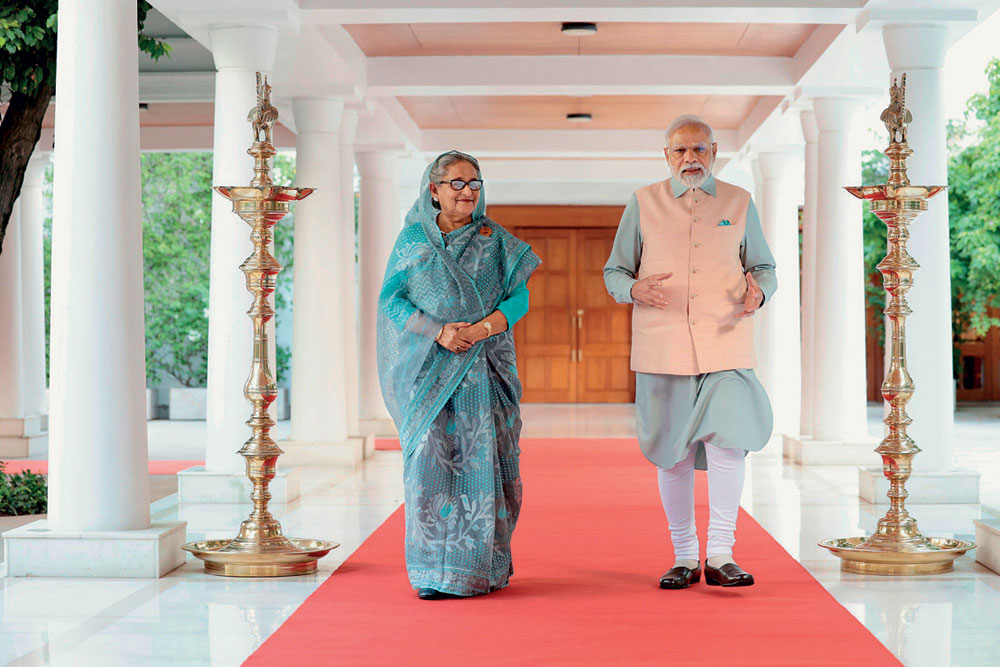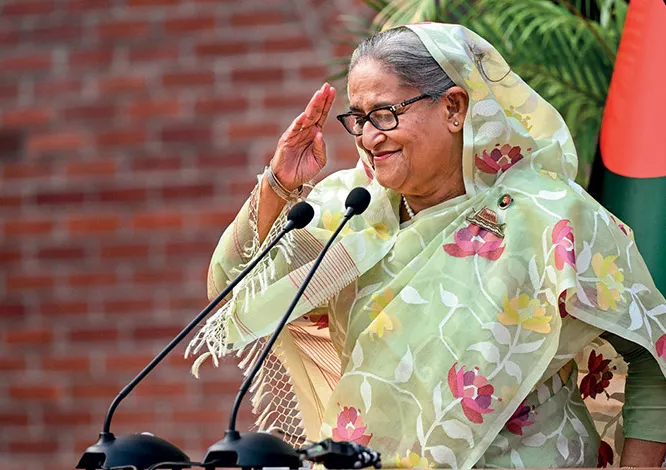IN THE END, the outcome was as predictable as the whole process. As Prime Minister Sheikh Hasina of Bangladesh ended up securing her fourth consecutive re-election, with her party claiming a majority of seats amid an opposition boycott, there was a sense of déjà vu which was hard to ignore. Defying not only her country’s opposition but also a large part of the international community, Hasina retained not only her grip on power but also her status as the world’s longest serving female head of government. This is a remarkable feat for a leader who has been targeted viciously by her political opponents, survived around 19 assassination attempts, was sent to jail and even had to face a revolt by the Bangladesh Rifles.
For all the challenges, Sheikh Hasina has been successful in giving Bangladesh a semblance of normalcy through a highly tumultuous period. The political stability that she has ushered in has allowed the nation to perform well economically. Though there has been some economic distress post-Covid-19 and a resultant economic slowdown, Bangladesh has emerged as one of the fastest-growing economies in the region with the tripling of its per capita income in the last decade. At a time when most regional economies have faced negative headwinds, Hasina’s government has handled economic matters relatively sagaciously. Bangladesh’s determination under a resolute leadership has demonstrated what can be achieved if national priorities are defined and operationalised with vision and clarity. Notwithstanding an entrenched political polarisation in the country’s body politic, the focus on effective governance and economic issues in recent years has paid dividends.
Politics, however, is another matter. The latest elections have seen an official voter turnout of around 40 per cent in stark contrast to the around 80 per cent turnout in 2018. Those elections had seen the participation of the main opposition Bangladesh Nationalist Party (BNP). But this time it took a harder line, boycotting the elections after the Hasina government rejected its demand of holding elections under a caretaker government. Because of BNP shunning the electoral system, the Jatiya Party has emerged as the main opposition group in parliament by winning 11 of 300 parliamentary seats, while the governing Awami League won 222. It’s the independents who have rather curiously ended up with 61 seats.
After the election results were out, Hasina described her fifth term in power as a “victory of the people” and dismissed the opposition’s allegation that the vote was a “sham”. BNP is maintaining that their boycott has paid off as people have largely rejected the election process. As BNP’s Senior Joint Secretary General Ruhul Kabir Rizvi made clear: “A government of the dummy, by the dummy, for the dummy will be established if Hasina attempts to form any kind of government through this dummy election.”
Hoping to keep working with Bangladesh to “advance our shared vision for a free and open Indo-Pacific,” the US has not outright rejected the election outcome. It “shares the view with other observers that these elections were not free or fair” but given its strong stance before elections when it imposed visa restrictions on anyone deemed to undermine the objective of free elections, there is a tone of greater pragmatism emerging from Washington DC.
And it is here that India’s role becomes critical. New Delhi stood by Sheikh Hasina even when criticism against her had reached a crescendo in Western capitals prior to elections. It was India that engaged the US on behalf of Hasina and managed to bring her and Joe Biden together at the G20 summit in New Delhi. India made a strong case to the US about the indispensability of the Hasina government not only for Indian security interests but also for wider US priorities in the Indo-Pacific. While China and Russia were among the first nations to congratulate Hasina after the elections, Prime Minister Narendra Modi also called her and reiterated India’s commitment to further strengthening the “enduring and people-centric partnership” with its neighbour. In a separate letter, Modi underlined that as a close friend and trusted development partner of Bangladesh,India will continue to support Bangladesh’s aspirations and growth.
Despite her seeming victory, the challenge for Hasina has just begun. The legitimacy of her victory will continue to be questioned by the opposition and if the political turmoil is not handled wisely, it will end up hampering the economic recovery process. Hasina has to implement a set of economic reforms for the next tranche of loans by the International Monetary Fund and other bodies and for that she would require some political capital
Despite her seeming victory, the challenge for Hasina has just begun. The legitimacy of her victory will continue to be questioned by the opposition and if the political turmoil is not handled wisely, it will end up hampering the economic recovery process. Hasina has to implement a set of economic reforms for the next tranche of loans by the International Monetary Fund (IMF) and other bodies and for that she would require some political capital. Moreover, there is a looming danger of trade sanctions from the US and the wider West which might impact the nation’s the main foreign-currency-earning industry, its garment sector. Hasina will need to do some deft diplomatic balancing act.
What is clear, however, is that she will have the support of Delhi as she navigates the challenging times ahead. In more ways than one, Modi and Hasina have managed to usher in a golden phase in bilateral ties between the two neighbours. It remains a matter of fact that the two leaders have managed to put the relationship on an orbit few would have envisioned a few years ago. They have had the foresight to recognise the transformative potential of India-Bangladesh ties for each other’s developmental priorities as well as for wider regional imperatives.
Delhi’s unflinching support to the Hasina government during periods of internal and regional turmoil allowed a sense of trust to emerge, which was reciprocated by Dhaka in showing greater sensitivity to Indian concerns. The Modi government, despite domestic political challenges, got the Land Boundary Agreement (LBA) approved by Parliament and also accepted the verdict of an international tribunal in the maritime territorial dispute with Bangladesh, which went against India. As Delhi re-envisioned its foreign policy priorities with a shift to the Bay of Bengal, India-Bangladesh ties emerged as central to that foreign policy vision. From ‘Neighbourhood First’ to ‘Act East’, from connectivity to trade, from security to development, Dhaka’s centrality to India’s regional outlook is key not only for India realising its own interests but also for larger regional imperatives. If India is becoming more ambitious in defining its priorities on the eastern frontier, Bangladesh is more confident than ever in leveraging these opportunities to its advantages.

India’s Northeast can hope to gain significantly from this convergence, especially at a time when Delhi is focusing on the region like never before. For Delhi, development of the nation’s East and Northeast is a top priority and a strategic imperative. And that region can only achieve its full potential if it is better integrated with Bangladesh, thereby ensuring that India-Bangladesh connectivity projects will continue to be at the top of the agenda. It is important to recognise that this connectivity push is being shaped by a political dispensation in New Delhi which has been forthright about the challenges posed by illegal immigration.
INDIA’S PRIORITISATION of the Bay of Bengal in its regional re-imagination is not only a function of the collapse of the South Asian Association for Regional Cooperation (SAARC) but also a response to the tremendous opportunities that remain untapped in that maritime space. From making the Bay of Bengal Initiative for Multi-Sectoral Technical and Economic Cooperation (BIMSTEC) the core of its regional outreach to shaping the BBIN (Bangladesh, Bhutan, India, Nepal) Motor Vehicle Agreement, allowing for the possibility of Bangladeshi exports to Bhutan and Nepal via India, there is a new drive to operationalise the idea of a Bay of Bengal Community.
This will be even more significant as India’s desire to emerge as the locus of the Indo-Pacific narrative becomes even sharper in the coming years. Both traditional and non-traditional security issues shaping this maritime geography will be implicated in the evolving Delhi-Dhaka dynamic. The future of this relationship is likely to be governed by a very different set of factors, such as trade, connectivity, health, energy, and the aspirations of the youth.
There is also a growing desire on the part of the two nations to look beyond the Bengali-Bengali narrative and shape the engagement by bringing in new stakeholders. There is a sizeable Tamil and Telugu population in Bangladesh in the textile industry and tech space which will also be a driver in the coming years and growing numbers of Bangladeshi students and medical tourists are now visiting southern India, thereby changing the very complexion of this engagement.
Modi and Hasina managed to usher in a golden phase in bilateral ties between the two neighbours. The two leaders put the relationship on an orbit few would have envisioned. They had the foresight to recognise the potential of India-Bangladesh ties
Of course, there is always the all-pervasive China factor that has to be reckoned with. With most of India’s neighbours, China has a seeming advantage that unlike India it is not part of the domestic political calculus; but unlike India, it also does not have a long-term stake in the South Asian region. It can afford to ignore the region, which it does when its interests are not served. Delhi doesn’t have that luxury. For Bangladesh, India remains its key link to the West which is increasingly wary of the Hasina government. And as Sri Lanka has demonstrated, China’s commitment during times of crises is extremely dubious. So while China will remain an important player in Bangladesh, India’s unique role in the country is difficult to neutralise. The Bay of Bengal is emerging as a critical maritime space in shaping the strategic contours of the Indo-Pacific and the India-Bangladesh partnership will be key to leveraging the opportunities and meeting the challenges.
Hasina’s victory will also put the spotlight on India in so far as New Delhi will have to fend off Western pressure about domestic politics in Bangladesh and make the West understand that the only beneficiary of a hardline attitude vis-à-vis the Hasina government will be China. Challenges, therefore, remain but the leadership in the two countries has indeed ushered in a transformative moment in bilateral relations and regional geopolitics. If Delhi and Dhaka are able to build upon the gains of the past decade and realise the full potential of their partnership, not only will South Asia be able to emerge as the anchor in the wider Indo-Pacific, but the people of India and Bangladesh will also be able to once again write another chapter in their shared destinies.
This commentary originally appeared in Open.
The views expressed above belong to the author(s). ORF research and analyses now available on Telegram! Click here to access our curated content — blogs, longforms and interviews.





 PREV
PREV


